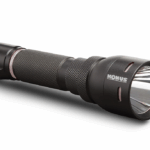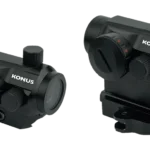So here we are at the end of our course on riflescopes. We started from the vocabulary to arrive at the concepts of lift and drift and magnification. Now we face two main topics: reticle and brightness!
RETICLE
The reticle will be placed in one of the two focal planes and overlapping the framed image, will provide the shooter with aiming, establishing the point of impact of the jet on the target. The difference between a reticle positioned on the first or second focal plane is the position where it is placed that is to say whether at the front or at the end of the erector tube.

If it is a reticle in the first focal plane, the reticle remains superimposed on the image before it passes through the erector, the reticle will become larger and larger as you zoom in while if the reticle is on the second focal plane, it remains unchanged even when the magnification is changed. The reticle placed in the firts focal plane has the advantage that any references (as mil dot reticle) will be valid at any magnification, on the other hand reticle thickness may be thin at low magnifications and too thick at other magnifications representing an impediment to aiming.

The reticles on second focal plane if they are mil dot or with ballistic references, the estimate will be possible only at a precise value of the zoom factor (highlighted on the magnification ring). It is also important to have riflescopes with an engraved rather than a glue reticle that is, there are cheaper riflescopes that have a wire reticle due to the molding of a thin sheet of metal, this causes it to detach. If instead the reticle is photoengraved resistance is guaranteed and even more complex reticles can be obtained with this technique.
In the riflescope we find then rings, knobs, button turrets for any other electronic functions, first of all the illumination of the reticle. The fewer junction points you will on your riflescopes, the higher its quality will be, both in terms of dust and humidity tightness and in terms of sturdiness.
BRIGHTNESS
Each time light passes through a lens, some image brightness is lost due to the reflections phenomenon that is to say that a some light just “bounces off” the surface and create a reflection. To limit this loss of light, surface treatments are carried out with anti-reflection layers which minimize the phenomenon. If an untreated lens trasmits 86% to 96% of light depending on its quality, with this treatment you can reach 99.5%. Based on the number of layers deposited on the lens of this anti-reflection treatment we would have coated or multicoated optics. If we want to guarantee that all the lenses of the optics have been treated (and not just the external surfaces) then you need to choose a fully multicoated riflescope.
Refraction too fights against the light that passes through the lens that is the say the various frequencies of the light beam are deflected in different directions. The phenomenon can be avoided by gluing together several lenses with different curvatures and refractive indices, causing the different frequencies that form the colors to recompose when they come out of the instrument. This phenomenon can lead to chromatic aberration ie colored halons that form around more defined contours. Also the glare for the scattered light can be annoying because it worsens the contrast, the detail and color quality of the image. This can be remedied coating the inside of the scope with a low-reflection black layer.
Other problems you may hear about that relate to peripheral vision imaging are as follows:
– Spherical distortion: it is due to the shape of the lenses and it has the effect of warping flat target surfaces that appear concave or convex
– Astigmatism: warps the image with a main image in focus and a secondary image out of focus
– Coma: comet effect on the peripheral luminous points of the visual axis
– Vignetting: image brightness drop if you move from the center to the edges
So now you know how much complex mechanics there is inside a riflescope. It is obvious that there are many concepts now just touched but this path we are convinced it can enable you to grasp the quality elements of a riflescope and to make the right choice when it comes to thinking about your perfect model. We are sure that in the Konus range you can find the answer to your needs with that attention not to make you spend decidedly excessive amounts when you can now have excellent products at completely reasonable prices. Indeed over the years, enormous progress has been made and quality test we made prove that quality is no longer the prerogative of merely expensive products and we are happy to be able to make it accessible to everyone with truly amazing products. Seeing is believing!






